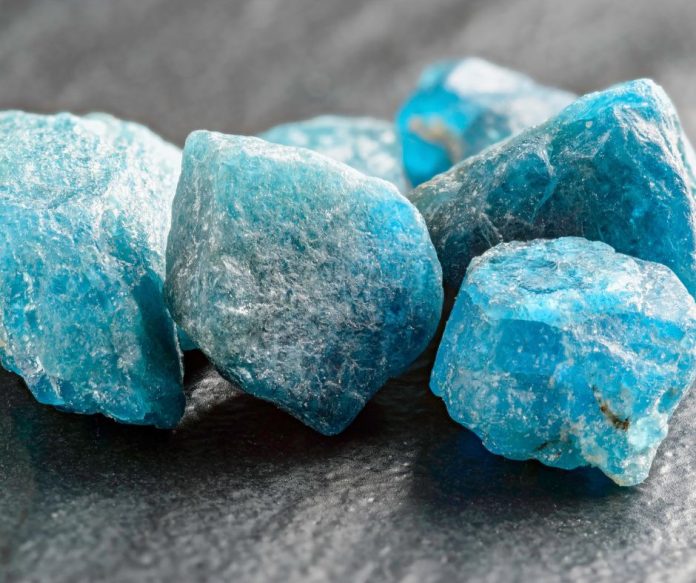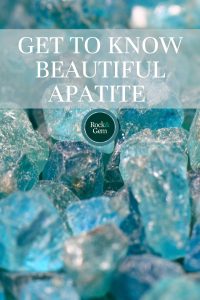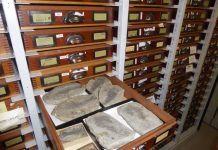
Apatite crystals are a favorite among collectors with their stubby, terminated, hexagonal prisms, glassy transparency, and soft, yellow-to-greenish-yellow or blue mineral colors. These beautiful crystals rank high on blue gems and minerals lists. Much is mined in Mexico.
However, most of the apatite in the Earth’s crust occurs not as macrocrystals, but in microscopic form within a coarse-grained, buff-to-brown, sedimentary rock called phosphate rock. The extraordinary industrial and agricultural importance of phosphate rock drives a multi-billion-dollar mining industry.

Apatite is a group name that refers to 17 related minerals. In collectors’ usage, the name refers to any of three minerals: fluorapatite [calcium fluorophosphate, Ca5(PO4)3F, formerly apatite-(CaF)]; chlorapatite [calcium chlorophosphate, Ca5(PO4)3Cl, formerly apatite-(CaCl)]; and hydroxylapatite [basic calcium phosphate, Ca5(PO4)3(OH), formerly apatite-(CaOH)].
Similar, But Different Minerals
Because the fluorine, chlorine, and hydroxyl ions in these three minerals have similar electrical charges and ionic radii, they substitute readily for each other in a partial, three-ended, solid-solution series. All occur in close association, share similar properties, and require laboratory analysis for differentiation.
Apatite is critical both to our physical well-being and our global food supply. In the form of apatite, phosphorus is essential to plant life for growth and photosynthesis, and to animal life as a vital component of genes, teeth, bones, and muscles.
Fluorapatite, the hardest, most durable and abundant, of the three apatite minerals, is the primary component of vertebrate bones and teeth. When fluoride compounds are added to drinking water and toothpaste, fluorine ions displace chlorine and hydroxyl ions to convert chlorapatite and hydroxylapatite to fluorapatite, thus improving the decay-resistance of teeth.

Although collectible apatite crystals occur in hydrothermal deposits and granite pegmatites, most apatite exists in the form of collophane. This microcrystalline or massive form of apatite is a major component of marine sedimentary rocks deposited by ancient seas. The collophone supported large populations of plankton and other tiny, invertebrate organisms—the phosphorus-rich remains of these organisms mixed with sea-bottom sediments eventually lithified into phosphate rock.
High-grade phosphate rock, the only commercial source of phosphorus, contains at least 10 percent elemental phosphorus in the form of apatite. As the base of the 25-billion-dollar-per-year global mining industry, more than 255 million tonnes of phosphate rock are mined annually from open pits. After concentration, an acid treatment converts the apatite into a hydrated calcium phosphate called “superphosphate.”
Superphosphate Uses
Most superphosphate is used to formulate nitrogen-phosphorus-potassium (N-P-K) agricultural fertilizers. The remainder is processed into elemental phosphorus and phosphoric acid, the feedstock materials for the manufacture of insecticides, herbicides, matches, pyrotechnics, nutritional supplements, and a host of other products.
As demand for phosphorus-based chemicals increases, high-grade phosphate rock now sells for about $100 per tonne. China accounts for half the annual global production; Morocco and the United States together account for about one-quarter of production.
But many mines are rapidly depleting, and Morocco alone controls 90 percent of the world’s phosphate-rock reserves. In 1974, Morocco increased its reserves by unilaterally annexing the adjacent, former Spanish territory of Western Sahara with its massive Bou Craa phosphate-rock mine. Today, Western Sahara, a Wyoming-sized expanse of desert, is a disputed territory claimed by Morocco and the Polisario Front, the political-military organization of the indigenous Sahwari people.
Bou Craa’s phosphate-rock reserves—about four billion tonnes—are the world’s largest. The Bou Craa open-pit mine is an example of the extraordinary steps that nations will take to obtain phosphate rock. A 60-mile-long conveyer belt, the world’s longest, transports Bou Craa’s newly mined phosphate rock to the Atlantic coast, while the “Moroccan Wall,” a 1,700-mile-long, 12-foot-high, military-patrolled, human-made sand escarpment protects the mine and Moroccan-occupied Western Sahara from Polisario guerilla attacks. The mine, its conveyor belt, and the Moroccan Wall are all visible from space.
Apatite minerals will always be in demand by collectors for those beautiful, transparent, yellow-to-greenish-yellow crystals and, much more importantly, by industrial factions for phosphate rock which, while not visually appealing, is vital to global food production.
This story about apatite previously appeared in Rock & Gem magazine. Click here to subscribe. Story by Steve Voynick.
















